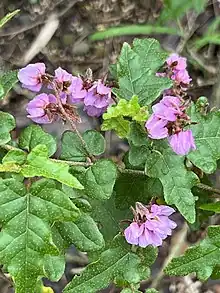Thomasia brachystachys
Thomasia brachystachys is a species of flowering plant in the family Malvaceae and is endemic to the Southwest Australia south-west of Western Australia. It is an open, erect shrub with egg-shaped to heart-shaped leaves and pink to mauve flowers.
| Thomasia brachystachys | |
|---|---|
 | |
| Scientific classification | |
| Kingdom: | Plantae |
| Clade: | Tracheophytes |
| Clade: | Angiosperms |
| Clade: | Eudicots |
| Clade: | Rosids |
| Order: | Malvales |
| Family: | Malvaceae |
| Genus: | Thomasia |
| Species: | T. brachystachys |
| Binomial name | |
| Thomasia brachystachys | |
Description
Thomasia brachystachys is an open, erect shrub that typically grows to a height of up to 1.5 m (4 ft 11 in) and has a single stem at ground level, its stems densely covered with star-shaped hairs. The leaves are arranged alternately, egg-shaped to heart-shaped, 35–80 mm (1.4–3.1 in) long and 25–65 mm (0.98–2.56 in) wide on a petiole 12–20 mm (0.47–0.79 in) long. The edges of the leaves are lobed, the lower surface covered with star-shaped hairs and the upper surface becoming glabrous with age. There are oval, stem-clasping, densely hairy stipules up to 7 mm (0.28 in) long at the base of the petioles. The flowers are arranged in racemes of 5 to 8, about the same length as the leaves, each flower on a short pedicel, and about 10 mm (0.39 in) in diameter. The sepals are pink to mauve, joined for about half their length and there are bracts and broadly elliptic bracteoles at the base. The petals are small and scale-like, the five stamens free from each other, and the style no longer than the petals. The fruit is a dehiscent capsule.[2][3][4]
Taxonomy and naming
Thomasia brachystachys was first formally described in 1852 by Nikolai Turczaninow and the description was published in Bulletin de la Société Impériale des Naturalistes de Moscou.[5][6] The specific epithet (brachystachys) means "a short flower spike".[7]
Distribution and habitat
This thomasia grows in woodland and forest at higher altitudes in the Stirling Range National Park and near Gnowangerup.[2][3]
Conservation status
Thomasia brachystachys is classified as "Priority Two" by the Western Australian Government Department of Biodiversity, Conservation and Attractions,[3] meaning that it is poorly known and from only one or a few locations.[8]
Use in horticulture
This thomasia is described as an attractive species that has proved reliable in a range of conditions when grown in well-drained, humus-rich soil. It can be propagated from both seed and cuttings and is moderately drought and frost hardy.[2]
References
- "Thomasia brachystachys". Australian Plant Census. Retrieved 30 October 2022.
- Blake, Trevor L. (2021). Lantern bushes of Australia ; Thomasias & allied genera : a field and horticultural guide. Victoria: Australian Plants Society, Keilor Plains Group. pp. 14–15. ISBN 9780646839301.
- "Thomasia brachystachys". FloraBase. Western Australian Government Department of Biodiversity, Conservation and Attractions.
- Richardson, B. "Thomasia". Florabase-the Western Australian Flora. Department of Biodiversity, Conservation and Attractions. Retrieved 2 November 2022.
- Turczaninow, Nicolai Stepanovitch (1852). "Thomasia brachystachys". Bulletin de la Société Impériale des Naturalistes de Moscou. 25 (3): 143. Retrieved 2 November 2022.
- "Thomasia brachystachys". Australian Plant Name Index. Retrieved 2 November 2022.
- Sharr, Francis Aubi; George, Alex (2019). Western Australian Plant Names and Their Meanings (3rd ed.). Kardinya, WA: Four Gables Press. p. 143. ISBN 9780958034180.
- "Conservation codes for Western Australian Flora and Fauna" (PDF). Government of Western Australia Department of Parks and Wildlife. Retrieved 31 December 2022.
